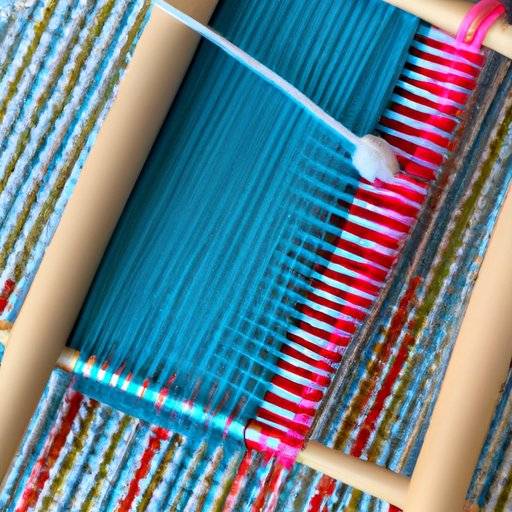Introduction
Are you looking for a new creative outlet that can provide benefits for your mental health and well-being? Look no further than loom knitting and weaving. This versatile craft has a rich history and can offer a range of therapeutic benefits. This article will provide a comprehensive guide for beginners, covering the essential materials and techniques needed, as well as its cultural significance. Additionally, we’ll explore how loom weaving is evolving with modern technology and how it is impacting the economy. Finally, we’ll provide some inspiring project ideas to get you started.
A Beginner’s Guide to Loom Knitting
Loom knitting is a form of knitting that uses a specially designed loom instead of traditional needles. It’s an excellent option for beginners, as it’s easier to learn and less time-consuming than traditional knitting. All you need to get started is a loom, yarn, and some basic knitting tools such as a crochet hook and a pair of scissors.
There are different types of looms to choose from, including round looms and long looms. Round looms are perfect for making hats and circular items, while long looms are ideal for scarves and other rectangular projects. The yarn comes in different weights and textures, and you should pick one that corresponds to your project’s needs.
Setting up a loom and casting on stitches is simple and straightforward. You can find plenty of tutorials online, but the basics involve wrapping the yarn around the loom’s pegs and using the crochet hook to pull the bottom loop over the top one.
There are a variety of techniques and stitches you can learn, such as e-wrap, knit stitch, and purl stitch. Depending on the type of stitch you use, you can create different patterns and textures that will enhance the look of your projects. Practice and patience are key, and you’ll be creating beautiful handmade items in no time.
Like any craft, loom knitting has its common mistakes and problems. If you’re struggling with tension, dropped stitches, or other issues, don’t worry. There are many resources and tips available to help you troubleshoot and correct these issues.
The History and Evolution of Loom Weaving
The origins of loom weaving are difficult to trace, as it’s been practiced by many different cultures throughout history. Loom weaving has been significant in many aspects of people’s lives, like their economic, social, and religious activities. Historically, the craft was passed on as oral traditions, and as a result, it’s hard to pinpoint how it spread through different cultures.
Despite its mysterious history, we do know that loom weaving has been used to create everything from clothes to carpets to tapestries, and has always been an essential part of various cultures and societies. The technology and methods of loom weaving have evolved significantly over time.
The most significant change in loom weaving was the invention of the power loom in the early stages of the Industrial Revolution. This technology allowed looms to be operated by steam and later electricity, which increased production and made textiles more accessible. This introduction of modern machinery led to a significant shift in textile production, and many people moved from weaving by hand to discovering more industrialized methods.
Inspiring DIY Loom Projects to Try at Home
One of the best things about loom knitting is the endless project ideas available. Whether you’re looking to create a unique item for yourself or a gift for a loved one, there are plenty of easy and engaging DIY projects to choose from.
One project idea is to create a cozy infinity scarf using a long loom and some super soft yarn. Another project could be learning to make a market bag using a round loom and some cotton yarn. You could also use a long loom to create a beautiful baby blanket for a new arrival using a simple stitch, and the possibilities are endless.
The Benefits of Loom Weaving for Mental Health and Well-Being
There is growing evidence demonstrating that creative hobbies like loom weaving can provide benefits for mental health and well-being. The repetitive, rhythmic movements of the craft can help reduce stress, anxiety and provide a mindfulness practice that centers one’s focus and attention. These practices regulate breathing and can produce an overall calmness and tranquility. This creative outlet is a great way to destress after work or wind down before bed.
Additionally, loom weaving can provide potential social benefits, like creating community and meeting other makers. Whether you join a knitting club or attend a crafting retreat, there are many ways to connect with other creative individuals, create new friendships, and learn about the art of loom weaving.
The Rise of the Loom Knitting Industry and Its Impact on the Economy
The popularity of loom knitting has led to an increase in business selling loom knitting products and loom weaving materials. Cottage industries have grown, where individuals can support themselves creating and selling handmade loom knitting items to buyers who are looking for unique, high-quality items. Additionally, the rise of fair trade practices helps to sustainably support economies worldwide and provide sound economic development opportunities for cottage industries networks.
Conclusion
As we’ve seen, loom knitting and weaving are versatile crafts with a rich history and a range of benefits for mental health and well-being. Whether you’re a beginner or an experienced crafter, there are endless project possibilities, and it’s easy to get started. If you’re looking for a new creative outlet, think about picking up a loom and trying your hand at this enjoyable craft.
